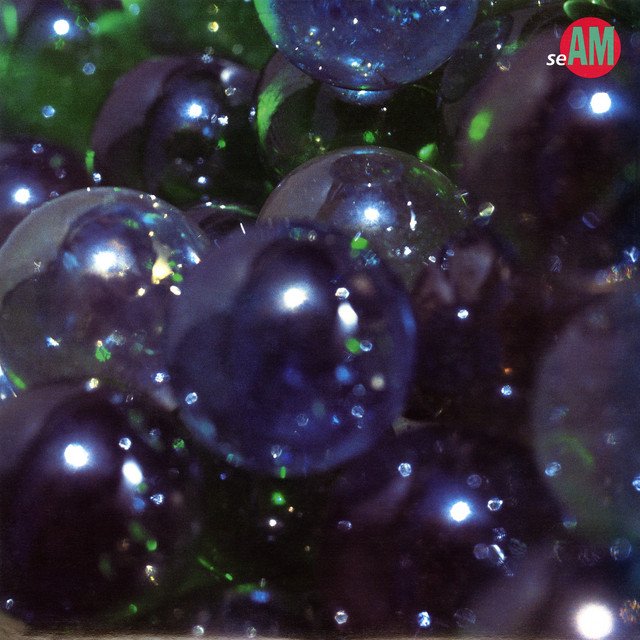Little band, big city: the tragically ignored awesomeness of Seam.
A look back at one of Chicago’s great forgotten rock bands.
artwork by Asher Stone.
There are a lot of legends in music. Seriously, think of how many artists you’d describe as “legendary.” I mean, you’ve got your usual suspects: the classic rockers, the OG rap gods, your pop stars, all the jazz masters, probably a lot of great classical composers. The list is endless. But for now, forget about all those people—the Led Zeppelins and Tupacs and Taylor Swifts of the world—because this article isn’t about a legend. This article is about a random, mostly-forgotten group from the ‘90s who made a few good albums and retired, for the most part to never be heard from again. This article is about Seam.
A little context: the story of Seam begins with Sooyoung Park, who, by the time he formed Seam, had already changed the course of music once. During his college days at Oberlin, Park played in the excellent but perennially-underrated post-hardcore outfit Bitch Magnet, who would set the stage for much of the math rock and post-rock that would come out in the ‘90s. But that’s another day and another article. After the dissolution of Bitch Magnet (read: graduation), Park moved to Chapel Hill with bassist Lexi Mitchell. After a few gigs, the duo met Mac McCaughan of Superchunk, who soon joined them on drums, making the group a power trio. After cutting their first album, the Pixies-meets-Neil-Young-esque Headsparks in 1992, Park and Mitchell cut ties with McCaughan (who left the band to focus on his much more successful main gig in Superchunk) and moved to Chicago, where they enmeshed themselves into the local indie scene and signed with Touch & Go (Park had already worked with Steve Albini a few years prior on Bitch Magnet’s Star Booty EP). Their 1993 release The Problem With Me would be the last album to feature Mitchell before Park would replace her with William Shin. Park would break up the band in 1994 before returning a year later with the grungier Are You Driving Me Crazy? The new lineup would stay constant long enough to put out one more album, the aptly-named The Pace Is Glacial in 1998 (firmly cementing their slowcore style) and a Korean tour in 2000 before breaking up for good.
There’s not much to be found on Seam’s history, which feels fitting. Seam was never a way of life. More often than not, it seems, they were just four dudes jamming away and hanging out. In fact, the most notable impact that Seam had on the world wasn’t even musical. Along with journalist Ben Kim, Park and Shin would co-found the Foundation for Asian American Independent Media in 1995. Park’s most famous musical contribution might be helping Justin Lin score Better Luck Tomorrow. But ultimately, the story of Seam, nondescript as it is, is the story of hundreds of great-but-known bands throughout history: continuity-breaking lineup changes, going-nowhere tours, and awesome albums that would go unlistened. But let’s talk about those albums.
Headsparks
Headsparks fits comfortably into the wave of “quiet-loud” works that would come out after Nevermind, though it’s a testament to the band’s skills that it sounds so fully-formed. Park’s guitar is gloriously staticky, sounding almost like a distorted banjo. McCaughan is rock-steady behind the kit, while Mitchell’s oddly catchy basslines anchor the melodies, allowing Park to fly off into his expert displays of fuzzed-out, guitar-hero riffage. Park’s quiet-but-intense vocals serve as an instrument themselves, conveying all the fury of a full-throated shout while being mixed low enough that they blend with the guitar and bass.
Opening track “Decatur” is a nice bit of proto-Midwest emo, with its shifty intro rhythm predicting the languid tempo changes of Braid and Cursive, while Park’s uncharacteristically prominent vocal melody gives the whole thing an emotional charge that isn’t always found on the rest of the album. Guest vocalist Sarah Shannon gives the album’s most conventionally pretty vocal performance on “Shame,” while McCaughan barrels behind her like he’s been dropped into a Minor Threat practice without warning. On the other end of the spectrum, the languid, Slint-like arpeggios and militaristic rhythms of “Feather” provide a link between the avant-noise slowcore of Codeine and the more accessible emo-grunge Sunny Day Real Estate would popularize a few years later. Overall, Headsparks is a solid introduction to the post-Nirvana wild west of ‘90s weirdo indie, and a remarkable debut of a band that would only get better.
The Problem With Me
If you go to Seam’s Wikipedia page, you’ll find that they’re classified as slowcore. Whether or not you fully agree with that estimation, it’s not implausible that someone would come up with it. Listening to the atmospheric guitars of “Bunch” or the haunting, stark bassline of “Autopilot,” it’s easy to hear how Seam easily slotted themselves into the post-American Music Club landscape of melancholic, spaced-out “sadcore” rockers, despite the energy that coursed through their previous album (it’s also worth noting that Park had known the members of Codeine back when he was at Oberlin). Indeed, The Problem Is Me is where Seam dropped the hardcore punk aggression that had characterized Headsparks and fully embraced their emo side.
That’s not to say that The Problem With Me is neutered. The distorted rave-up of “Rafael” proves otherwise, as do Park’s lyrics throughout the album, which drip with angst and anger (a sample: “I am with you / I could kill you”). But it’s a much more melodic album. The gentle, interlocking guitar arpeggios of “Road To Madrid” could pass for a Mark Kozelek composition, while “The Wild Cat” indulges itself in a fist-pumping arena rock riff on the chorus. There’s even a bit of straight-up guitar pop with “Something’s Burning,” where Mitchell cribs most of Boston’s “More Than A Feeling” to create what might be the catchiest bassline of all time. Part of that is the introduction of Craig White on guitar—the presence of a second guitarist would give Park someone to play his ideas off, and White’s presence allows for more obviously sophisticated compositions—indeed, even after White left the group, Park would bring on another guitarist instead of going back to playing solo. Among Seam fans, The Problem With Me is generally seen as the group’s best album, a view which I’m inclined to agree with. It’s the sound of a group finding lightning in a bottle and going as far as they can with it. It’s awesome.
Are You Driving Me Crazy?
I once heard someone describe Are You Driving Me Crazy? as “the most ‘90s album of all time,” and, quite frankly, I’m inclined to agree. I mean, there’s a ripping, balls-to-the-wall grunge track about the Latasha Harlins killing (“Hey Latasha”) complete with new drummer Chris Manfrin doing his best Damon Che impression on the chorus. If that doesn’t scream “1990s,” I don’t know what does. Actually, more than anything else, I want to talk about Manfrin.
As I said before, there was a membership change between The Problem With Me and Are You Driving Me Crazy?, whereupon Park established what would become the de facto Seam lineup for a whole 5 years: himself and Reg Schraeder on guitars, William Shin on bass, and Manfrin on drums. And if I’m going to be honest, it’s generally worse. Schraeder favored more conventional alt-rock chordwork over White’s more delicate math-rock sensibilities, and Shin lacked the poppy melodicism of Mitchell. Manfrin, on the other hand, is a badass on the drums. Unlike McCaughan or The Problem With Me drummer Bob Rising, Manfrin went firmly over the top, letting loose with fills, slipping into jazz (check the clock-like pulse of “Tuff Luck”), and generally doing all he can to sound like the proggier version of Dave Grohl. Of all Seam’s drummers, he’s easily the best, and his madcap skill redeems the weaker moments of Are You Driving Me Crazy? and its follow-up The Pace Is Glacial.
The album’s obvious highlight is the throttling emo-rocker “Halo Redux,” where Park dips into White-era arpeggios while Manfrin forgoes any sense of rhythm in favor of dropping fill after fill. And when Park pushes his voice up the front of the mix, just in time for a triumphant cry of “I’m in love with this feeling,” it’s the most optimistic that any Seam song has ever sounded. “Port Of Charleston” is a similar high point; Park dips his toe into classic-rock guitar noodling with triumphant results, dropping a noisy, churning solo into what could have otherwise been a bit of dull slowcore-by-numbers.
The greatest legacy of Are You Driving Me Crazy?, and the reason why it’s received such a lengthy write-up, is how it so clearly showed the beginning of the end for Seam. With Mitchell’s departure, Park had lost his closest collaborator and the entire album is built around her absence and his internal conflict Just listen to his lyrics: “I’m sick of taking it you know, but I can’t walk away,” “I meant what I said and I can’t forget how I felt,” “I did things that I can’t forgive.” Instrumentally, too, the band would increasingly become “the Sooyoung Park show.” Suddenly, there would be drawn-out solos and a clear lead-rhythm guitar divide rather than the interlocking beauty of the Park-White pairing. If this brings to mind Billy Corgan, another Chicago-based guitar hero who would turn his band into a solo project (while also making concessions to his godlike drummer), you’re not alone in thinking it. Sooyoung Park may never have been a rock star, but he would take his band out in rockstar fashion nonetheless.
The Pace Is Glacial
Almost every band has their black sheep. Their Momentary Lapse of Reason. Critically maligned, forgotten by fans, usually recorded a fair bit of time after their most iconic works. Seam is no exception. It’s not a bad album, though. It’s just conventional. It’s apparent from the opening riff of “Little Chang, Big City” that what you’re getting isn’t going to be the tense, meticulous post-hardcore of Seam’s previous work, but instead something a little looser and noisier, and maybe a little more obviously emo or indie. Again, not bad. But perhaps The Pace Is Glacial commits an even worse crime than being bad; a bad Seam album that sounds like a bad Seam album is one thing, but this is an alright Seam album that doesn’t even sound that much like a Seam album.
That’s not to say that it isn’t worth a listen. The Pace Is Glacial does have its high points, and it’s not a coincidence that they’re the moments that sound most like they could have come from a previous album. With its furious, polyrhythmic drumming and proto-American Football guitar melody, standout track “The Prizefighters” sounds like it could have slotted comfortably anywhere on Seam’s first two releases. Indeed, it may be one of the best songs that Park ever put out, proving that even when he was in a rut, he was capable of producing gems. Similarly, the outro of “In The Sun” sports a genuinely ripping groove, as well as a passable attempt at a Mitchell bassline from Shin. Short and sweet, the minute-and-a-half-long “Wig” is genuinely pretty, and provides a nice sample of what Park might have done had he chosen to go in a more post-rock direction. And the pummeling riff of “Intifada Driving School” is a nice bit of Hüsker Dü-lite punk. Overall, The Pace Is Glacial isn’t all that bad of a sendoff for Seam, even if it could have been better. It’s the sound of Park trying to make changes, even if they weren’t always good ones. And after ten years of making great music, Park had certainly earned the right to go his own way. Listen to this one. It might surprise you.
edited by Alondra Romero.
cover art by Asher Stone.
album artwork believed to belong to either the publisher of the work or the artist.





